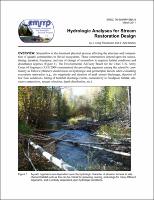Please use this identifier to cite or link to this item:
https://hdl.handle.net/11681/4042Full metadata record
| DC Field | Value | Language |
|---|---|---|
| dc.contributor.author | Fischenich, J. Craig, 1962- | en_US |
| dc.contributor.author | McKay, S. Kyle | en_US |
| dc.creator | Environmental Laboratory (U.S.) | en_US |
| dc.creator | Ecosystem Management and Restoration Research Program (U.S.) | en_US |
| dc.date.accessioned | 2016-03-16T16:16:15Z | en_US |
| dc.date.available | 2016-03-16T16:16:15Z | en_US |
| dc.date.issued | 2011-03 | en_US |
| dc.identifier.govdoc | ERDC TN-EMRRP-EBA-08 | en_US |
| dc.identifier.uri | http://hdl.handle.net/11681/4042 | en_US |
| dc.description | Technical Note | en_US |
| dc.description.abstract | Streamflow is the dominant physical process affecting the structure and composition of aquatic communities in fluvial ecosystems. These communities depend upon the source, timing, duration, frequency, and rate of change of streamflow to regulate habitat conditions and disturbance regimes (Figure 1). The Environmental Advisory Board for the Chief, U.S. Army Corps of Engineers (EAB 2006) summarized the prevailing argument among the scientific community as follows: planners should focus on hydrologic and geomorphic factors when evaluating ecosystem restoration (e.g., the magnitude and duration of peak annual discharges, duration of low flow conditions, timing of bankfull discharge events, connectivity to floodplain habitat, substrate composition, stream velocities, depth distribution, etc.). Engineers compute many of the above hydrologic parameters for analysis and design of conventional water resources as well as for restoration projects. Planners can and should take advantage of these analyses to support their efforts for ecosystem restoration projects. Guidance on the computation of the more common hydrologic parameters is provided in this technical note. An understanding of the hydrologic conditions and the changes therein over time is essential for problem identification. This generally occurs in conjunction with the development of a conceptual model for the project (Fischenich 2008). Hydrologic parameters can serve directly as metrics for evaluating project alternatives, or they can be used as the basis for habitat, population, or other models used for benefits analysis. Hydrologic parameters are also inevitably used in evaluating project success and for determining the need for adaptive management actions. | en_US |
| dc.description.sponsorship | Ecosystem Management and Restoration Research Program (U.S.) | en_US |
| dc.description.sponsorship | Environmental Benefits Assessment Research Program (U.S.) | en_US |
| dc.format.extent | 17 pages/896 KBs | en_US |
| dc.format.medium | PDF/A | en_US |
| dc.language.iso | en_US | en_US |
| dc.publisher | Engineer Research and Development Center (U.S.) | en_US |
| dc.relation | http://acwc.sdp.sirsi.net/client/en_US/search/asset/1004212 | en_US |
| dc.relation.ispartofseries | Technical Note (Ecosystem Management and Restoration Research Program (U.S.)) ; no. ERDC TN-EMRRP-EBA-08 | en_US |
| dc.rights | Approved for public release; distribution is unlimited | en_US |
| dc.source | This Digital Resources was created in Microsoft Word and Adobe Acrobat | en_US |
| dc.subject | Stream restoration--Design | en_US |
| dc.subject | Streamflow--Analysis | en_US |
| dc.title | Hydrologic analyses for stream restoration design | en_US |
| dc.type | Report | en_US |
| Appears in Collections: | Technical Note | |
Files in This Item:
| File | Description | Size | Format | |
|---|---|---|---|---|
| ERDC-TN-EMRRP-EBA-08.pdf | 892.82 kB | Adobe PDF |  View/Open |